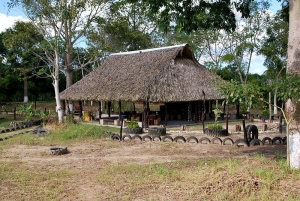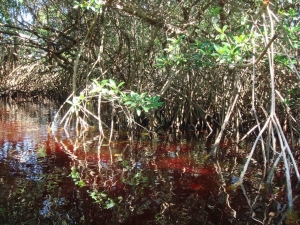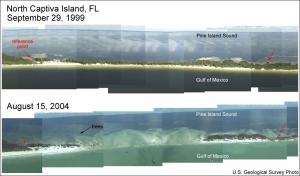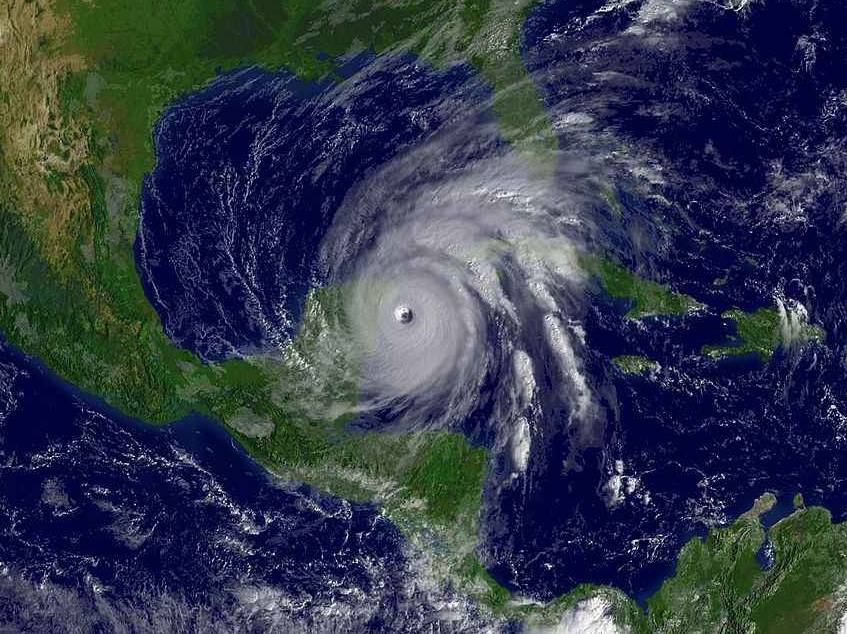When Hurricane Wilma hit Dave and Nancy’s Yucatan house in 2005, it hit it so squarely that afterwards all the phone poles north of town were on the ground pointing west, and all the phone poles south of town were on the ground pointing east. Dave picked us up at the airport and driving back you could look right through the jungle—not a leaf anywhere. It had been completely defoliated. One billboard after another was flat on the ground, and Dave had been wandering the neighborhood looking for the palapa that had been on his rooftop terrace. Palapas are thatched structures used for shade in the Yucatan. They’re made of logs.

-
Palapa
By Thelmadatter[CC BY-SA 3.0], via Wikimedia CommonsWe all know what a hurricane can do to a city, but a friend of ours who regularly visits Dave and Nancy with us asked me recently what hurricanes do to ecosystems. It was an interesting question that I had never asked myself. What is the natural effect, and the natural response, to an insanely violent event like a hurricane? If we remove human beings from the picture for a moment—our cities, our hotels, all our other misdeeds and miscalculations—then what goes on in coastal ecosystems during a hurricane? Chatting with Susan about the question that night over cocktails, I made a prediction: I predicted that when I looked into this I would find that the organisms in tropical coastal ecosystems not only can handle hurricanes, but need them. It wasn’t the most brilliant or daring prediction, but anyway it looks like I was right.
A hurricane is not only a violent event, it is a chaotic one, and when I say that, I’m not using hyperbole, I’m using mathematics. Chaos mathematics was invented by a guy named Edward Lorenz, and he was a meteorologist—he was trying to write a computer program to model world weather patterns. Hurricanes in particular and weather systems in general are so complex that predictability itself is defeated, and chaos theory is what Lorenz developed in order to analyze the stuff. Inherent in chaos theory is what Lorenz called the “butterfly effect,” the idea that a tiny change in initial conditions, like the flap of a butterfly wing, can have a huge effect down the line—like a hurricane.
Which is one reason no two hurricanes are the same. You might experience anything from lashing winds to rising sea levels to the breaching of barrier islands and sudden exposure to the open ocean, or it may just park above you and dump torrential rain for several days. A large hurricane can have a storm surge at its center where the sea level is thirty or forty feet higher than normal, and that’s in deep water—before it hits the coast and the ocean floor runs up under it and everything stands up into breaking waves. It can redraw coastlines by 100 meters or more. Katrina and Rita alone sent over seventy square miles of our fair land into the deep blue sea, but hurricanes also deposit huge amounts of sediment and nutrients and raise the soil level in coastal marshes and keep them from subsiding and becoming open water. Estuarine channels and waterways may protect the coast against the storm surge, and you may feel fortunate to live at the end of one, but they can also focus and funnel the surge, depending on their shape, with the result that, hours after the battering, when you’re looking at clear skies and thinking you’ve survived it, a wall of water suddenly flattens you and everything around you. The National Hurricane Center used to offer up storm surge measurements along with its one-through-five Saffir-Simpson category rating, but they finally threw up their hands and gave up on it. The whole thing was just too localized, and their credibility was going to hell. What happens to you in a hurricane depends on where you are, what you’re up to, and how the gods of chaos mathematics are feeling that day. Only one thing’s for certain: it will change your life. Right underfoot, or paw, or flipper, things will change. Your world will be different in the morning.
And nature just loves that. It loves it to death. I’ve said this in more than one article: the balance of nature may be a balance, but it’s not a stasis. Things out there are constantly in motion, and organisms have evolved accordingly. The idea of a permanent community that never goes anywhere and would be devastating to lose, is a peculiarly human notion. What the natural world is full of is opportunists, and change is their medium, chaos is their opportunity generator. Mind you, they don’t have to like it, and any one organism in a hurricane may live or may die, but according to my reading, the communities tend to do just fine in the long term, and in fact need what the hurricanes bring them.

-
Mangrove forest in the Yucatan. The red water is from the tannin of the mangrove trees.
Photo by Susan Fry
Mangrove forests are a delightfully unlikely plant community. They occur all over the tropics in shallow coastal waters and fine, depository soils, but the word “mangrove” actually doesn’t have a taxonomical meaning. These trees and shrubs are all a case of convergent evolution—innovative desperados from a wide variety of family backgrounds who have all figured out a way to live with their roots submerged in saltwater, which is really a pretty impressive trick when you think about it. Heck, most trees will suffocate if you submerge their roots even in fresh water. Roots simply have to have free oxygen, it’s that simple, and also, salt levels that high are in opposition to every osmotic process in their bodies. Mangrove species each employ a different array of tricks, but they all pull it off—they send things called pneumatophores up into the air like little breathing straws, or they get oxygen through special organs in their bark called lenticels and send it down from there; they have subcellular mechanisms in their roots that admit water but exclude salt, or they dump the salt they ingest into their older leaves and then drop them in the drink like little garbage bags. They stand absurdly on spindly, stilt-like roots, and the dense network of roots slows tidal actions and causes the deposition of the fine silt they need, creating their own soil exactly the way they like it. Red mangroves (Rhizophora spp.) produce seedpods that look a lot like large string beans, but what’s different about them is that the seeds germinate right inside the pod before it drops into the salt water and floats away. After it has drifted awhile, it redistributes its weight and goes from floating horizontally to vertically, so that its bottom end nudges up against the silt and it can establish itself. And this is even cuter: if it fails to establish itself, it will redistribute its weight again and float away horizontally to try somewhere else. Mangrove ecosystems are just bizarre—if you were a working god in a design room somewhere with the other working gods and you proposed a mangrove forest, you would be laughed out of the place. Yet they cover three quarters of tropical coastlines, and the habitat is rich, home to all manner of crustaceans and mollusks and sessile (attached) organisms, and a tremendously important nursery for small fishes. And they do protect the coastline from the worst ravages of the hurricane, but not from all of it, and also, they themselves are changed by it, and they adapt. After the storm there may be several inches added to the underwater soil among all those stilt roots, and they immediately start sending out rootlets horizontally in the new layer, stabilizing it and soaking up the windfall of new nutrients.
Forests may get completely defoliated by the wind, but the only knock-downs are usually at the edges. (As human development fragments the forests, there is much more of this edge habitat, and much more damage.) After the storm an entire forest’s worth of leaves starts decaying in the inland bodies of water, depleting oxygen and causing huge fish kills. Arboreal lizards are suddenly completely exposed to airborne predators in the leafless forest, and may try to drop down to the lower branches for protection, but will be competing there with better-adapted creatures designed for the job.
Migratory birds cross the Gulf of Mexico toward the end of hurricane season, and if a hurricane is threatening, they’re smart enough to wait for better weather before taking off. They have enough fat to power the 600-plus-mile crossing, but only in reasonable conditions, and in the end they’re as imperfect as we are at predicting the weather, and they can get caught out. Bird migrations are not as hard-wired as people think, though, and if they land in their usual location and the place has been stripped of all fruit, leaves and insects, they’ll continue on, looking for better stuff. If they get blown hundreds of miles off-course, they will look around for a stopover that works, and regroup. (Human developments are making these stopover habitats harder to find for exhausted birds.) Thousands of birds can perish in a hurricane, or starve in its aftermath if they don’t know how to deal with something like a leafless forest. Cavity nesters get hit particularly hard following a hurricane, because trees with cavities are by nature weak or already dead, and go down in the wind a lot, often snapping right at the cavity. When Hugo hit the Carolinas in 1989, one forest lost 87% of its nesting trees and 67% of its red-cockaded woodpeckers (Picoides borealis). The bird populations can rebound in four or five years if they’re otherwise healthy, but of course it’s the species that are already in trouble that get hammered. The Puerto Rican parrot (Amazona vittata ) got its numbers halved by Hurricane Hugo in 1989—from 47 birds down to 23. But even as all these creatures are enduring huge death tolls, they are also taking advantage of the shifting patchwork of habitats. Edge habitats and transitional habitats are rich places. Opportunity abounds.

-
North Captiva Island, before and after Hurricane Charley
By United States Geological Survey [Public domain], via Wikimedia Commons
Barrier islands are skinny spits of sand running parallel to coastlines, and they are created by—and reshaped by, and destroyed by—natural oceanographic forces, mostly wave dynamics. Scientists have been proposing theories about their formation since 1845, but to this day you could walk into any oceanography symposium and assert any theory, and you’d more than likely end the evening with a black eye. The islands may have vegetation on them, even groves of trees, but make no mistake, at the end of the day they are sand spits, and they are quite fragile. There’s a whole rank of them along the U.S. Gulf Coast, and in the shallow sounds between them and the mainland are great beds of sea grass, rich incubators and nurseries, full to bursting with shrimp and other crustaceans, young bony fishes and turtles. Hurricanes overtop the islands and open up new channels through them, suddenly exposing the mainland to direct waves from the storm. Whole sand dunes get washed into the sound and bury the sea grass beds, but the beds recover quickly, and even the channels blown through the islands heal themselves in following years. Hurricane Charley, in 2004, opened a new channel fully a quarter mile wide through North Captiva Island, a barrier island off Florida (fully developed and inhabited, of course). By 2010 the gap had closed again through natural processes.
Coral reefs are notoriously fragile, but really only because they live in a human-infested world. They don’t actually mind hurricanes that much, and branching coral like staghorn coral (Acropora cervicornis) even relies on strong storms to distribute itself. It does reproduce sexually once a year through broadcast spawning (that’s the practice of throwing sperm and eggs into the water and hoping for the best), but its dominant mode of reproduction is through fragmenting. Storms break off branches and sweep them away, and they are able to reattach to the substrate and start new colonies. It’s classic opportunism: after a hurricane staghorn coral leaps to life and recolonizes explosively, turning the most destructive storms on the planet to their advantage—but there’s a problem with it, too. The problem is that it is asexual reproduction, and doesn’t generate a lot of genetic diversity, and staghorn coral consequently hasn’t handled a changing world very well. Disease and changes in temperature or salinity give it real trouble, and staghorn coral is currently classified as critically endangered.
Well, to wrap up the story of the first organisms mentioned in this yarn, Dave and Nancy are both okay. They’ve evolved their own survival mechanisms, and one of them is a sense of humor. The two of them actually survive about one of these things per year on average, and they’ve gotten pretty good at it. Once they had just received and installed thousands of dollars worth of new windows when they found themselves in the sights of a hurricane. Dave raced through the house uninstalling them all again, so the storm could blow through the structure. It worked.
It’s all about handling change.
Now you know.
Copyright © 2012 Randy Fry


One more great article. Thanks Randy.
Another brilliant article, bro.
I learned a lot as usual, and thanks as always!